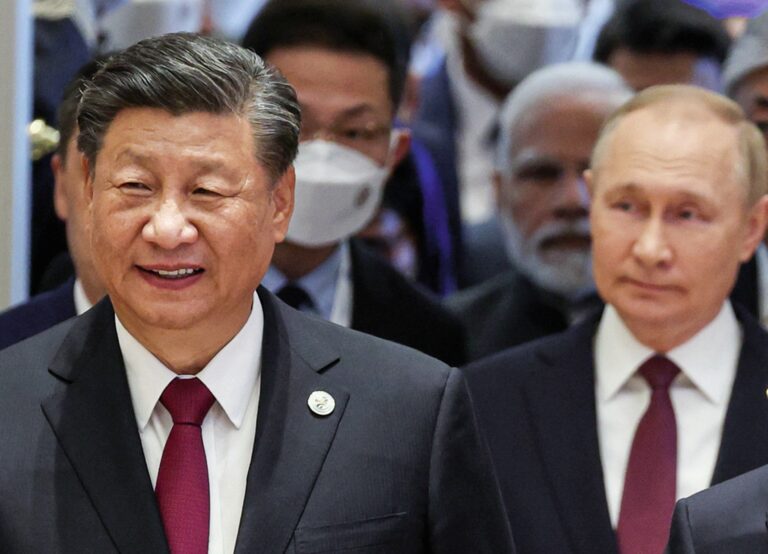
Some twenty years ago I had dinner with the exiled and subsequently strangely deceased Russian oligarch, Boris Berezovsky. He told me that Russia should sell a long lease of large swathes of Siberia to China. ‘We have too much unproductive land’ he said, ‘and they have too many people’.
A bonkers idea I thought. If Siberia became settled with mostly Chinese immigrants, Russia would never get it back - rather like Mexico, which lost Texas to the US after it allowed settlement by American farmers. But, in Berezovsky’s idea there was at least the germ of an idea that now propagates the Sino-Russia relationship.
The meeting last week between President Vladimir Putin and Xi Jinping at the Shanghai Cooperation Organisation summit in Samarkand (Uzbekistan) was another reminder, if one was needed, that the world has moved into a new era of geopolitical bipolarity: China - Russia versus America - Europe.
The nature of the China-Russia relationship is not love. By comparison - however fractious as it may be at times - migration, culture, and family bind the America-European entente. The China-Russia alliance is different. The relationship is transactional.
European Russia, going as far as Archangel and Perm in the East, accounts for 75 percent of its total population but only 20 percent of its land. Since its modern foundation in 1547 by Ivan the Terrible, Russia has sought to be first and foremost a European country. Over generations it fought its way to the Baltic in the North and the Black Sea in the South. Peter the Great and his cousin Catherine the Great, a native German, finally succeeded where Ivan had failed.
However, as the Russian historian Lobanov-Rostovsky wrote in 1928, Russian history is a ‘perpetual swinging of the pendulum between two poles of attraction’. Having achieved their European ambitions, in early 20th Century Tsar Nicholas II sought to achieve Russia’s Asian objectives by conquering the northern Chinese province of Manchuria while at the same time establishing a warm water port at Vladivostok. The resulting Russo-Japanese War, essentially a battle for control of China and Korea, ended with the catastrophic sinking of Russia’s Navy at the Battle of Tsushima [1905] – arguably a major factor in the Soviet overthrow of the Romanovs.
This did not end Russian interest in Asia. Having defeated the allied American-Japanese-British army in Asia in the aftermath of the Russian Revolution, Stalin continued to secure his eastern flank. A war was fought with Japan on the Manchurian-Mongolian border in the summer of 1939 and at the end of the Pacific War, Stalin invaded Manchuria and overwhelmed Japan’s armies.
In the post-war period, when Stalin behaved as ‘big-brother’ to Mao Zedong’s communist revolution, Manchuria was returned to China. However, as Communist China consolidated its power, relations between Russia and China deteriorated. From 1964 onwards, border clashes became a constant narrative of their relaionship until 2008, when a comprehensive Sino-Russian Border Line agreement was signed.
In effect this was the date from which we can now trace the start of the current Sino-Russian relationship that has brought us to Cold War 2.0. In 2008 many would have perceived this as a relationship of equals. It was not true then and it is even further from the truth now. In 2008 the GDP of China was three times that of Russia; today it is six times. The meeting at Samarkand confirmed that Russia is now de facto a client state of China. The tone of speeches and body language between Xi and Putin has noticeably changed since their February declaration of ‘friendship without limits’.
The ineptness of Russia’s military in Ukraine has undoubtedly impacted its international reputation. At the Shanghai Co-operation Summit in Samarkand, India’s Prime Minister Modi, who had remained schtum after Russia’s invasion of Ukraine, was brutal in his assessment. ‘Today’s era is not of war,’ he told Putin; he needed to ‘move onto a path of peace’. Central Asian states, formerly part of the Soviet Union, and already being suborned by Chinese money, are also likely to yaw more sharply in that direction.
On the one hand Xi must be disappointed with the performance of his ally in the Ukraine War, on the other hand Russia’s failure has handed Xi an opportunity. Putin will no doubt seek Chinese finance and technology particular in military equipment, but China will gain access to cheap Russian oil and gas as well as metal and soft commodities.
The eastern portion of the Power of Siberia pipeline from Sakhalin Island through Vladivostok opened in 2019 and is currently supplying about 5 billion cubic metres (bcm) of gas per annum. That should increase to 38 bcm per annum by 2025 as the western section of Power of Siberia comes online. Chinese gas demand is growing at 12.5 percent per annum and could over time replace the 150 bcm of Russian sales to Europe last year.
The transactional direction of Russia’s relationship with China is now set. This could change. But not under a Putin; the Russian leader has burnt his boats with the West. Putin may not have handed China a lease of land as suggested by Berezovsky, but Putin has effectively hawked Russia’s future to its more powerful neighbour.
However, a future leader of a Russia might decide that it is no longer desirable to be the handmaiden of China. A yaw back to the West could take place; after all, that is the historic nature of Russia’s see-saw relationship with Europe and Asia. And the dumbbell that balances European Russia with Asian Russia is, in terms of history, cultural and population, heavily weighted toward the former.